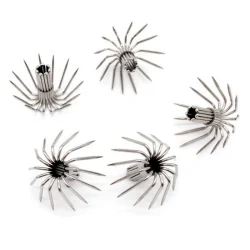How to Maintain and Care for Your Fishing Tackle
2024-09-02
Investing in quality fishing tackle is crucial for a successful fishing experience, but maintaining your gear is just as important. Proper care and maintenance will extend the life of your tackle, ensuring it performs well for many fishing trips to come. Here’s how to keep your fishing tackle in top condition.
1. Clean Your Rod and Reel After Each Use
After a day of fishing, especially in saltwater, it’s essential to clean your rod and reel. Saltwater can corrode metal parts, so rinse your rod and reel with fresh water to remove salt, dirt, and debris. Use a soft cloth to wipe them down, and make sure to dry all parts thoroughly to prevent rust.
2. Lubricate Moving Parts
Keeping the moving parts of your reel lubricated is vital for smooth operation. Apply a few drops of reel oil to the handle, bail, and other moving parts. Avoid over-lubricating, as excess oil can attract dirt and grime. Check your reel’s manual for specific lubrication points and recommendations.
3. Inspect and Replace Fishing Line
Your fishing line is constantly exposed to the elements and can become weak or damaged over time. Before each trip, inspect your line for fraying, nicks, or knots. Replace the line if you notice any signs of wear, especially if it’s been a while since you last changed it. Monofilament lines should be replaced every season, while braided lines may last longer but still require regular checks.
4. Store Tackle Properly
Proper storage is key to preventing damage to your tackle. Keep your rods in a vertical position, preferably on a rod rack, to avoid warping or bending. Store your reels in a cool, dry place, and consider removing the line if you won’t be using them for an extended period. Use your tackle box to organize and protect smaller items like hooks, lures, and sinkers. Make sure everything is dry before storing to prevent mold and rust.
5. Check Hooks and Lures
Inspect your hooks and lures regularly to ensure they’re sharp and in good condition. Dull hooks can be sharpened with a hook file, but rusty or heavily damaged hooks should be replaced. Make sure the eyes of the hooks and lures are free of debris, and the split rings and swivels are intact.
6. Maintain Your Tackle Box
Your tackle box is the hub of your fishing gear, so keep it clean and organized. Wipe down the compartments regularly to remove dirt and moisture. Organize your gear by type and size to make it easy to find what you need on the water. If your tackle box becomes damaged or difficult to close, consider replacing it to protect your gear.
7. Replace Worn Out Tackle
Fishing tackle wears out over time, even with proper care. Regularly assess the condition of your gear and replace items as needed. This includes lines, hooks, lures, and any other components that show signs of wear. Keeping your tackle in good shape ensures you’re always ready for a successful fishing trip.
Conclusion
Taking the time to maintain and care for your fishing tackle will pay off in the long run, extending the life of your gear and improving your fishing experience. By cleaning your rod and reel, inspecting your line and hooks, and storing your gear properly, you can ensure that your tackle remains in excellent condition for many fishing trips to come. Treat your fishing gear with care, and it will serve you well on the water.



